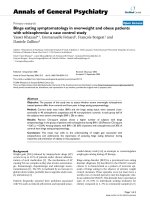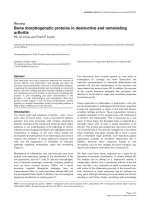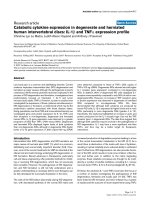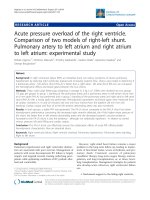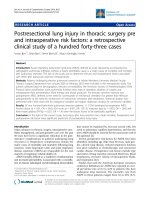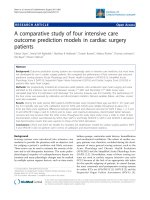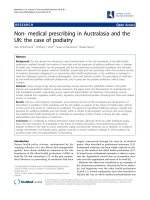Báo cáo y học: "Acute kidney injury in the intensive care unit: current trends in incidence and outcome" potx
Bạn đang xem bản rút gọn của tài liệu. Xem và tải ngay bản đầy đủ của tài liệu tại đây (32.23 KB, 2 trang )
Page 1 of 2
(page number not for citation purposes)
Available online />Abstract
Acute kidney injury (AKI) is a common clinical problem with
significant clinical and economic consequences. A number of
studies point to a rising incidence of AKI in the hospital and in the
intensive care unit over the past several years, and an increase in
the degree of co-morbidity associated with it. Recent evidence
suggests that there has been some improvement in outcomes over
time. Nevertheless, the mortality associated with AKI remains
unacceptably high, and further work is needed. Recently
developed consensus definitions will be useful in this regard.
Bagshaw and colleagues [1] report on the epidemiology and
outcomes of acute kidney injury (AKI) in Australian intensive
care units (ICUs) over a ten year period. It has been said that
despite technological advances in nephrology, there has
been little improvement in the outcomes of patients with AKI
[2]. The literature has been confounded by the use of varying
definitions of AKI, reliance on coding for AKI in administrative
databases, and lack of adjustment for severity of illness and
co-morbidities. Nevertheless, it is undisputed that there has
been a notable increase in AKI incidence [3,4], and this has
important economic implications.
The work by Bagshaw and colleagues [1] confirms the rising
AKI incidence, but focuses on the critical care setting. Using
a large multicenter ICU adult database, they noted that AKI
incidence increased almost 3% annually from 1996 to 2005.
Since the ANZICS definition of AKI remained constant, their
results are less likely to be affected by changes in coding
practices over time. This Australian study now corroborates
this ‘epidemic’ of AKI, at least in the ICU. As it is, this is an
alarming trend. Furthermore, as they identified only AKI
present within the first 24 hours of ICU admission, this
underestimates the magnitude of the problem. Interestingly,
the increase in AKI incidence does not appear to be entirely
due to the older and sicker patients now in our ICUs, who are
more prone to develop AKI. Indeed, the Acute Physiology
And Chronic Health Evaluation (APACHE) score and
Simplified Acute Physiology score (SAPS) of AKI patients
have remained unchanged over the ten-year period. Instead,
the trend for increasing AKI incidence is also seen in the less
severely ill groups of patients: those with no co-morbid illness
and elective ICU admissions. This may be in part related to
the fact that the present study refers only to AKI on
admission, and is based on blood creatinine levels. This
criterion will tend to underdetect AKI in older patients with
smaller muscle mass. In addition, it is possible that this group
of patients develops ‘delayed’ AKI, that is, after the first
24 hours of ICU admission. It has been suggested that this
rise in AKI incidence is due to more aggressive diagnostic
and therapeutic interventions in more recent years [5].
Reassuringly, however, we are seeing an apparent decline of
early AKI in certain subgroups, such as hematological
malignancy, trauma and cardiovascular surgery [1]. Even
more encouraging is that there has been an apparent
decrease over time in the mortality of AKI patients, with an
annual decrease of 3.4% per year. This change persisted
after adjustment for several factors, such as age, co-morbidity
and severity of illness.
Although the ANZICS study is unable to provide us with the
answers, we can speculate as to the possible reasons for this
change. As suggested by the authors, this may be due to
overall improvement of ICU care, as well as better
collaboration between intensivists, nephrologists and other
subspecialties. It is interesting, however, that there was no
change in mortality over time in the non-AKI group, raising
doubt that this is the only factor. It may well be that
Commentary
Acute kidney injury in the intensive care unit:
current trends in incidence and outcome
Dinna N Cruz
1,2
and Claudio Ronco
1
1
Department of Nephrology, Ospedale San Bortolo, Vicenza, Italy
2
Section of Nephrology, Department of Medicine, St Luke’s Medical Center, Quezon City, Philippines
Corresponding author: Dinna N Cruz,
Published: 24 July 2007 Critical Care 2007, 11:149 (doi:10.1186/cc5965)
This article is online at />© 2007 BioMed Central Ltd
See related research by Bagshaw et al., />AKI = acute kidney injury; AKIN = Acute Kidney Injury Network; ICU = intensive care unit; RIFLE = Risk-Injury-Failure-Loss of renal function-End-
stage renal disease.
Page 2 of 2
(page number not for citation purposes)
Critical Care Vol 11 No 4 Cruz and Ronco
improvements in dialytic care, with the now widespread use
of biocompatible membranes, improved machinery and
increasing attention to dose in both continuous and inter-
mittent renal replacement therapies, contributed to better out-
comes. This is congruent with a US study in which crude
mortality in AKI that required dialysis decreased over a
15 year period [3]. Another potential explanation is the
availability of less nephrotoxic alternatives for various drugs
and contrast agents. This may also be related to a reduction
in the use of old therapy mainstays such as ‘renal dose
dopamine’ and diuretics which, under scientific scrutiny, have
not been found to be effective. Perhaps this may be due to
increased awareness and recognition of AKI.
Despite the apparent decline in mortality in AKI patients, it
remains unacceptably high at around 40% [1]. If indeed the
rising prevalence of AKI is due to our more ‘aggressive’
diagnostic and therapeutic approach, then prevention of AKI,
both primary and secondary, remains the key to continued
improvement in outcome. Ideally, we would like to be able to
prevent progression of AKI from milder to more severe forms;
therefore, timely intervention is crucial. Aside from how to
intervene, the other important question is when to intervene.
Over the time course of AKI, just like with sepsis, we can
distinguish between a biological and a clinical clock. The first
starts when there are alterations in renal perfusion and
damage to tubular cells. In contrast, the clinical clock starts
only when we see changes in serum creatinine and urine
output. Emerging biomarkers of AKI, such as neutrophil
gelatinase-associated lipocalcin and cystatin C, give us a
view of the biological clock, and the use of commercially
available assays for cystatin C has been increasing [6]. It will,
however, take time before this practice becomes universal,
particularly in developing countries. Until then, we have to
continue to rely on, and improve, the clinical clock. Currently,
consensus definitions for AKI exist and are being increasingly
used in the literature [7,8]. The advent of RIFLE (Risk-Injury-
Failure-Loss of renal function-Endstage renal disease) and
AKIN (Acute Kidney Injury Network) criteria provides us a
framework for identifying and staging AKI. This will not only
aid us in recruiting patients, but also serve as clinical
endpoints for evaluating interventions in AKI. In the future,
outcomes in AKI will include intermediate endpoints, such as
prevention in progression from milder to more severe forms of
AKI, analogous to what we now do in chronic kidney disease.
Competing interests
Both authors have participated in the Acute Dialysis Quality
Initiative workgroups.
References
1. Bagshaw SM, George C, Bellomo R, ANZICS Database Manage-
ment Committee: Changes in the incidence and outcome for
early acute injury in a cohort of Australian intensive care units.
Crit Care 2007, 11:R68.
2. Ympa YP, Sakr Y, Reinhart K, Vincent JL: Has mortality from
acute renal failure decreased? A systematic review of the lit-
erature. Am J Med 2005, 118:827-832.
3. Waikar SS, Curhan GC, Wald R, McCarthy EP, Chertow GM:
Declining mortality in patients with acute renal failure, 1988 to
2002. J Am Soc Nephrol 2006, 17:1143-1150.
4. Xue JL, Daniels F, Star RA, Kimmel PL, Eggers PW, Molitoris BA,
Himmelfarb J, Collins AJ: Incidence and mortality of acute renal
failure in Medicare beneficiaries, 1992 to 2001. J Am Soc
Nephrol 2006, 17:1135-1142.
5. Lamiere N, Van Biesen W, Vanholder R: The rise of prevalence
and the fall of mortality of patients with acute renal failure:
what the analysis of two databases does and does not tell us.
J Am Soc Nephrol 2006, 17:923-925.
6. Dejavaran P: Emerging biomarkers of acute kidney injury.
Contrib Nephrol 2007, 156:203-212.
7. Bellomo R, Ronco C, Kellum J, Mehta R, Palevsky P, the ADQI
workgroup: Acute renal failure-definition, outcome measures,
animal models, fluid therapy and information technology
needs: the Second International Consensus Conference of
the Acute Dialysis Quality Initiative (ADQI) Group. Crit Care
2004, 8:R204-R2121.
8. Mehta RL, Kellum JA, Shah SV, Molitoris BA, Ronco C, Warnock
DG, Levin A: Acute Kidney Injury Network: report of an initia-
tive to improve outcomes in acute kidney injury. Crit Care
2007, 11:R31.
